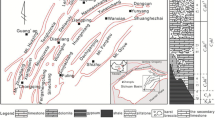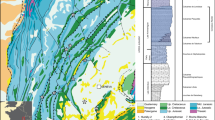Abstract
A set of typical Ordovician paleo-weathering crusts have developed in the dolomite reservoir of the Ma5 section within the Tabamiao region, Northern Ordos, China. The paleo-weathering crust of the dolomite reservoir is divided into two parts: the Ma 55 submember, which contains the dolomite reservoir, and the karst reservoir, which contains all sequences above the Ma 55 submember. The main rock types in the Ma5 submember are dolomite with gypsum and muddy to micritic dolomite. The lithologic facies are fracture breccia, crackle breccia, mosaic breccia, chaotic breccia, and matrix-rich mosaic breccia, which reflect the degree of corrosion in the research area. The reservoir lithology is dominantly powder to finely crystalline dolomite. The sedimentary sequence was important in the development of the karst reservoir. The results of the present study suggest that the carbonate reservoir was formed by constructive diagenesis, including dissolution, dolomitization, and fracturing. In addition, intercrystalline pores, dissolution pores, and fractures developed within the weathering crust of the dolomite reservoir. Furthermore, the dolomite contains a significant amount of porosity, which promoted development of the dolomite reservoir and was mainly formed by intercrystalline dissolution.
Similar content being viewed by others
References
Bish DL (1993) Rietveld refinement of the kaolinite structure at 1.5 K. Clays Clay Miner 41(6):738–744
Chen X, Yi W, Lu W (2004) The Paleokarst reservoirs of oil/Gas fields in China. Acta Sedimentol Sin 22(2):244–253
Choquette PW, Pray LC (1970) Geologic nomenclature and classification of porosity in sedimentary carbonates. AAPG Bull 54(2):207–250
Fang S, He J, Fang H et al (2009) Reservoirs pore space types and evolution in M55 to M51 submembers of Majiagou Formation of middle Ordovician in central gas field area of Ordos basin. Acta Petrol Sin 25(10):2425–2441
Feng Z, Zhang Y, Jin Z (1998) Type, origin, and reservoir characteristics of dolostones of the Ordovician Majiagou Group, Ordos, North China platform carbonate platform sediments. Sediment Geol 118(6):127–140
Fritz RD, Wilson JL, Yurewicz DA (1993) Paleokarst related hydrocarbon reservoirs. SEPM Core Workshop No. 18
Han B (1993) Study on micro-corrosion mechanism of Karst. Carsologica Sin 12(2):97–101
Hopkins JC (1999) Characterization of reservoir lithologies within subunconformity pools: Pekisko Formation, Medicine River field, Alberta, Canada. AAPG Bull 83:1855–1870
Huang S, Pei X, Xie Q (1995) Dickite and its significance in Ordovician carbonate reservoir of Shaganning Basin. J Chengdu 22(3):43–51
Huang S, Yang J, Zhang W et al (1996) Effects of gypsum (or anhydrite) on dissolution of dolomite under different temperatures and pressures of epigenesis and burial diagenesis. Acta Sedimentol Sin 14(1):103–109
Huang Z, Bao H, Ren J et al (2011) Characteristics and genesis of dolomite in Majiagou Formation of Ordovician, South of Ordos basin. Geoscience 25(5):925–930
Huang Z, Chen T, Ren J et al (2012) The characteristics of dolomite reservoir and trap accumulation in the middle assemblages of Ordovician in Ordos basin, China. Acta Petrol Sin 33(S2):118–124
Jia Z, Cai Z (2004) Carbonate paleo-weathered Crust reservoirs (body). Geol Sci Tech Inform 23(4):94–104
Jia Z, Cai Z, Xiao Y (1995) Paleo weathering crust: an important reservoir (body) type of carbonate rocks. Earth Sci 2(3):283–289
Jiang X, Wang S, Fan M et al (2008) Study of simulation experiment for carbonate rocks dissolution in burial diagenetic environment. Petrol Geol Exp 30(6):643–646
Joswig W, Drits VA (1986) The orientation of the hydroxyl groups in dickite by X-ray diffraction. N Jb Miner Mh 1:19–22
Kerans C (1988) Karst-controlled reservoir heterogeneity in Ellenburger Group carbonates of west Texas. AAPG Bull 72:1160–1183
Li J, Wang C, Fan T, Zhu L et al (1995) The characteristics of structure and texture of residual laterite and their genesis. Carsologica Sin 14(1):31–39
Loucks RG (1999) Paleocave carbonate reservoirs: origins, burial-depth modifications, spatial complexity, and reservoir implications. AAPG Bull 83(11):1795–1834
Loucks RG, Mescher PK, McMechan GA (2004) Three-dimensional architecture of a coalesced, collapsed-paleocave system in the Lower Ordovician Ellenburger Group, central Texas. AAPG Bull 88(5):545–556
Ma Y, Li Q, Guang D (1996) Carbonate microfacies characteristics and reservoir heterogeneity of the Ordovician weathering crust (O1 ma51-4) of the Zhongbu gasfield, Ordos basin, Northwest China. Acta Sedimentol Sin 14(1):22–32
Meng X, Zhang S, Li XA (2009) Discrimination and analysis of the structure of weathering crust of Ordovician at Tabamiao. Comp Tech Geophys Geochem Explor 31(4):381–387
Mutti M, Jadoul F (1991) Middle Triassic Paleokarst surfaces and associated stratigraphic patterns in platform carbonates: evidence from sedimentology and diagenesis, Southern Alps, Italy. AAPG Bull 75(3):643
Ran X, Fu J, Wei X et al (2012) Evolution of the Ordovician top boundary and its relationship to reservoirs’ development, Ordos basin. Petrol Explor Dev 39(2):154–162
Rauch HW, White WB (1977) Dissolution kinetics of carbonate rocks: l. effects of lithology on dissolution rate. Water Resour Res 13(2):181–194
Su Z, Chen H, Lin L et al (2010) Character of Palaeokarst and its reservoirs significance of Ordovician in Tabamiao area, Ordos. Xinjiang Geol 28(2):180–185
Wang B, Al-Aasm IS (2002) Karst-controlled diagenesis and reservoir development: example from the Ordovician main-reservoir carbonate rocks on the eastern margin of the Ordos basin, China. APG Bull 86(9):1639–1658
Wang B, Zhang G (2006) Diagenesis of Ordovician paleo-karst reservoir in the Sulige area, the Ordos. Petrol Geol Exp 28(6):518–522
Wu Y, He S, Tao L et al (2006) Diagenetic patterns and pore systems of the lower Ordovician Majiagou Formation reservoirs of the central Changqing gas fields. Acta Petrol Sin 22(8):2171–2181
Yang J, Huang S, Zhang W et al (1995) Experimental simulation of dissolution for carbonate with different composition under the conditions from epigenesis to burial diagenesis environment. Acta Sedimentol Sin 13(4):49–54
Yao J, Zhao Y, Lei B et al (2008) Sequence lith of facies Paleo geography of Western Ordos Basin in Majiagou stage, Ordovician. J Southwest Petrol Univ Technol Ed 30(1):33–37
Zhao W, Wang B (2011) Geochemical characteristics of dolomite from 5th member of the Ordovician Majiagou Formation in Sulige area, Ordos basin. Acta Geosci Sin 32(6):681–690
Zhou G, Cao Y (2010) Logging identification of weathering crust lithology and fluid types in the Tabamiao block, Ordos basin. Nat Gas Ind 30(3):40–43
Zhou W, Zhang S, Li L et al (2006) The character of upper Paleozoic reservoir fractures and the evaluation of their distribution in Tabamiao area of Ordos basin. J Miner Petrol 26(4):54–61
Zou X, Sun W, Zhang M et al (2006) Recognition of eroded channel-vale and top fluctuant configuration for Ordovician in Ordos basin. J Northwest Univ (Nat Sci Ed) 36(4):610–614
Acknowledgments
This article was funded by the demonstration project of the “Gas Field Development of the Erdos Basin Daniudi Tight National Major Special” (2011ZX05045).
Author information
Authors and Affiliations
Corresponding author
Rights and permissions
About this article
Cite this article
Meng, X., Wan, Y. & Bai, X. Characterization and origin of a dolomite reservoir in weathering crust: example from Ordovician in the Tabamiao Region, Northern Ordos, China. Carbonates Evaporites 33, 195–210 (2018). https://doi.org/10.1007/s13146-016-0314-5
Accepted:
Published:
Issue Date:
DOI: https://doi.org/10.1007/s13146-016-0314-5












